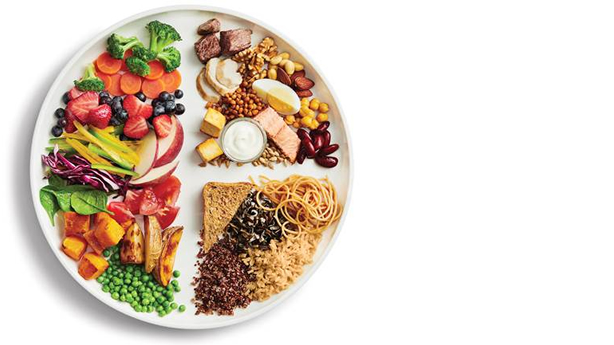One way to start improving your heart health immediately is to eat more vegetables and fruit. Along with their great taste and versatility, vegetables and fruit offer a host of heart-healthy nutrients.
Canada’s Food Guide recommends including plenty of vegetables and fruit in your meals and snacks. Filling half your plate with vegetables and fruit at each meal may help reduce your risk of heart disease and stroke.

This image is a copy of the version available at https://food-guide.canada.ca
Heart-disease prevention
Many vegetables and fruit are particularly rich in vitamin C and in beta-carotene, which is a form of vitamin A. These work as antioxidants in your body, helping to slow down or prevent atherosclerosis by reducing the buildup of plaque from cholesterol and other substances in the arteries.
Some of the vitamin C dynamos are:
- broccoli
- red peppers
- strawberries
- oranges
- kiwi
- cantaloupe.
Since beta-carotene gives food a distinctive dark-orange, red or dark-green colour, you can easily spot the best sources, such as:
- carrots
- tomatoes
- squash
- pink grapefruit
- sweet potatoes
- swiss chard.
Here's a bonus: almost all vegetables and fruit are low in calories, fat and sodium. In fact, research shows that high consumption of vegetables and fruit is associated with maintaining a healthy weight.
Good source of fibre
Eating vegetables and fruit provides a good source of fibre. Whenever possible, eat the peels, too – it will make a big difference to your total daily fibre intake. For example, a raw unpeeled apple has almost 10 times more fibre than a cup of apple juice.
Cooking fresh and frozen
Frozen and canned vegetables and fruit have about the same nutritional value as fresh. When buying frozen or canned fruit, look for the products with no-added sugar or syrup. Canned fruit packed in water is your best choice.
The best methods of cooking fresh or frozen produce is to steam, roast or grill to preserve as many nutrients as possible. If you're using canned vegetables, look for ones with no-added salt or rinse them under water to remove much of the added salt. Warm up to eat.
Related information
Find heart-healthy recipes.
Try these tips for getting more healthy produce into your diet.
Learn about a vegetarian diets.
